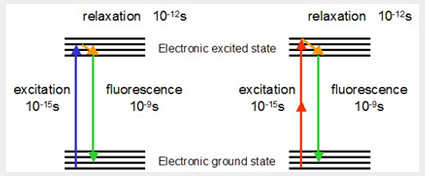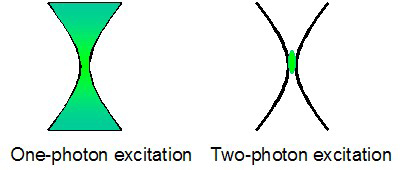What is the two-photon process?
Two-photon microscopy uses a two-photon excitation process of molecules and is referred to as two-photon excitation microscopy (TPE microscopy). Within a window of 0.1 femto-seconds one molecule can absorb two photons in the same quantum event (Figure 1). Commercialization of the tunable femto-second infra-red pulsed laser played a crucial role in the recent spread of two-photon microscopy in biological science. A pulsed (~100 femtosecond, ~100MHz) femto-second laser source can provide sufficient intensity for two-photon absorption to occur within a single pulse, while keeping a low enough average intensity (<20 mW) to avoid damaging specimens. The Ultima Multi-Photon Microscope is designed for imaging samples using a two-photon excitation process of fluorescence molecules as well as for studying the pharmacological effects of "caged compounds" through a two-photon absorption process of photolabile molecules.

Figure 1. Jablonski diagrams for one-photon excitation and two-photon excitation.
Pulse

Figure 2. Femtosecond laser pulses.
With an appropriate laser intensity, two-photon absorption occurs only at the focal plane of microscope objective, and the emission of fluorescence or the photolysis is confined in the focal volume of ~femto litter. Based on this principle, three-dimensional (3D) imaging can be achieved without using a pinhole as is the case for laser scanning confocal microscopy.
Focal Point

Figure 3. Schematics of one-photon versus two-photon fluorescence emission.


